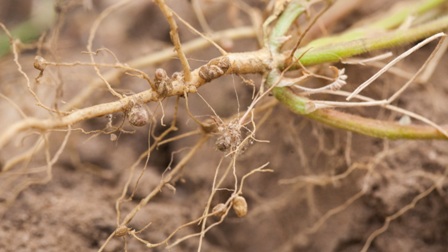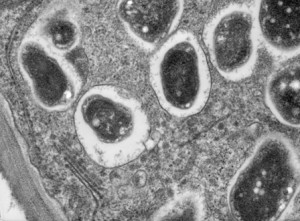Scientists Report First Step Away From Fertilizers
By XiaoZhi Lim (Original story)
BU News Service
Nodules – small, rounded bumps – on the roots of a soybean plant. These nodules contain nitrogen-fixing bacteria that can produce nitrogen compounds from atmospheric nitrogen for the plant. Photo courtesy of user Terraprima on Wikimedia Commons.
Before synthetic nitrogen fertilizers existed, plants and bacteria worked together to return nutrients to the soil. A type of bacteria living in plant roots, called nitrogen-fixing bacteria or Rhizobia, enriches the soil with nitrogen from the atmosphere, making it available to the host plants. But not all plants can host Rhizobia, because the plants’ immune systems repel the bacteria. Scientists have long believed that only legumes, or plants like soybean, pea, and alfalfa, could chemically communicate, and therefore accept, the nitrogen-fixing bacteria.
Gary Stacey, Professor of Soybean Biotechnology from the University of Missouri. Photo courtesy of Gary Stacey.
Recently, Gary Stacey and his team of researchers from the University of Missouri found that that might not be true. In an article from Science, Stacey and his group reported that legumes are not the only ones that can chemically communicate with Rhizobia. Their finding eventually could be important to farmers as a viable alternative to synthetic fertilizers.
In centuries past, farmers used manure or crop rotation to introduce nitrogen in the soil. They would spread limited quantities of manure on their fields, or plant legumes in between crops like corn or wheat to replenish nitrogen. With the development of synthetic nitrogen fertilizers about a century ago, getting nitrogen to plants became much simpler and more reliable than spreading manure or crop rotation. But synthetic nitrogen fertilizers created problems such as water pollution.
Scientists like Stacey have recognized that if they can figure out how the relationships between Rhizobia and legumes work, they can begin to expand the use of this 60-million-year-old partnership in farming.
The relationship between Rhizobia and legumes begins with an immune response, or the lack of one. As Rhizobia approaches plant roots in the soil, the plants treat Rhizobia as a threat and activate their immune systems. Rhizobia then sends out chemical messages that the legumes recognize, called Nod factors. The target plants withdraw their defenses and let Rhizobia infect them. The infection triggers a sequence of events that leads to Rhizobia settling inside special nodules in the legumes’ roots. From there, Rhizobia produces nitrogen for the legumes while the legumes provide food and shelter for Rhizobia.
For decades, scientists believed that non-legume plants like corn, wheat and tomatoes could not work with Rhizobia because they did not respond to the chemical messages and lower their defenses.
A transmission electron microscope image of the cross-section of a root nodule, showing the nitrogen-fixing bacteria living within plant roots. Image courtesy of Louisa Howard, Dartmouth Electron Microscope Facility on Wikimedia Commons.
Stacey and his research group learned otherwise, by accident, when they were studying plant immune responses. They showed that Arabidopsis, a non-legume plant commonly used in biological models, responded to Nod factors and lowered its immune defenses. This response was overlooked as it was commonly accepted between scientists that non-legumes could not recognize Nod factors, according to Katherine Gibson, a plant biologist at University of Massachusetts Boston. They also found similar effects with corn and tomatoes — signs that non-legumes can understand Rhizobia’s messages. Furthermore, with Arabidopsis, Stacey and his team identified a plant receptor that was highly likely to be responsible for recognizing Nod factors. “This is a very exciting finding,” said Gibson, explaining that a wider group of researchers studying plant immune responses would be interested in the receptor.
While Stacey’s findings brought researchers one step closer to understanding the Rhizobia and legume partnership, there is still a long way to go until a practical application of their research is available for farmers. Even though Stacey and his team found that Arabidopsis, corn and tomatoes all understood Rhizobia’s messages and lowered their immune responses, that only led to a small, localized infection, instead of triggering changes in the plants’ roots for Rhizobia to settle in. “That’s the step we need to focus on,” said Stacey. With further research, scientists like Stacey can help drive modern agriculture’s dependence on chemical fertilizers back to biological, benign ways to fertilize the soil.




